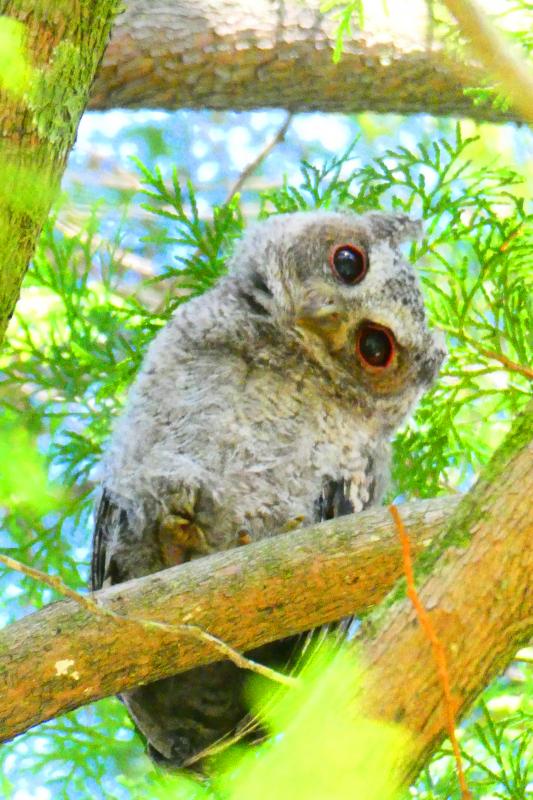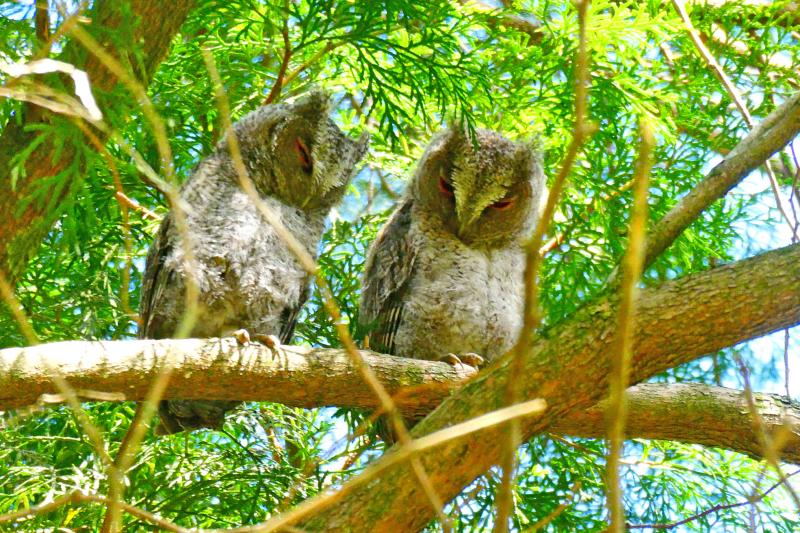Aowanda National Forest Recreation Area in Nantou County’s Renai Township has temporarily closed its doors to visitors to conform with the government’s nationwide level 3 COVID-19 alert. With nesting season currently underway, a family of collared scops owls — a protected species in Taiwan — has taken up residence in one of the park’s Taiwan incense cedar trees.
Although the recreation area is temporarily closed to the public, the epidemic prevention measures have not stopped its birds and bees from procreating. The months of May and June are nesting season, and things really come to life after dark. Within the recreation area it is possible to observe owls brooding, hear chicks chirping and see adult owls shuttling to and fro from their nests with morsels of food to help their little darlings grow up quickly.
Workers from the recreation area and research specialists from the Endemic Species Research Institute in the county’s Jiji Township were checking breeding boxes when they discovered a family of protected collared scops owls resting in a Taiwan incense cedar tree. The team believes there are at least four collared scops owls nesting in the tree. They have spotted them resting side-by-side in pairs or perching independently. The owls all had their heads tucked down and their eyes closed, sound asleep.

Photo courtesy of Aowanda National Forest Recreation Area 照片:奧萬大森林遊樂區提供
The team quickly grabbed the opportunity to photograph the charming scene, taking as many photos as possible of the owls. While the photographers were snapping away, one fledging owl discreetly opened its big, bright eyes and inclined its head to peek at the people below, which was captured on film to produce a surprisingly soporific photograph of the owlet’s adorably goofy expression.
(Liberty Times, translated by Edward Jones)
南投縣仁愛鄉奧萬大森林遊樂區因配合防疫三級警戒而休園,正值鳥類育雛期,園區的台灣肖楠樹上則有保育鳥類「領角鶚」家族現蹤。

Photo courtesy of Aowanda National Forest Recreation Area 照片:奧萬大森林遊樂區提供
奧萬大森林遊樂區因防疫而休園,生物的繁衍並不因此停歇,五、六月是鳥類育雛的季節,此時入夜時分,園區也能適時觀察到貓頭鷹的育雛畫面,幼鳥會發出「企、企、企」的叫聲,親鳥則會不停來回餵食,希望鳥寶寶快快長大。
園區工作人員與集集特有生物研究保育中心研究人員,日前在調查園區鳥巢箱的繁殖狀況時,就在台灣肖楠樹上發現正在休息的保育鳥類領角鶚家族,樹上至少有四隻領角鶚,有的兩兩相依,或是各據枝頭,每隻都是縮頭、閉眼,睡得香甜。
樹下的人們則是抓緊時機,拿起相機對著可愛的領角鶚家族猛拍,領角鶚幼鳥還會謹慎的睜眼查看,一雙水汪汪、圓滾滾的大眼睛,歪著頭看著樹下的人,呆萌的模樣讓人看了超療癒。
(自由時報佟振國)

South Korea’s famous kimchi is falling victim to climate change, with scientists, farmers and manufacturers saying the quality and quantity of the napa cabbage that is pickled to make the ubiquitous dish is suffering due to rising temperatures. Napa cabbage thrives in cooler climates, and is usually planted in mountainous regions where temperatures during the key growing summer season once rarely rose above 25 degrees Celsius. Studies show that warmer weather brought about by climate change is now threatening these crops, so much so that South Korea might not be able to grow napa cabbage one day due to the intensifying heat. “We

On blazing hot summer days, fresh ingredients and cool refreshments straight from a refrigerator feel like nothing short of a miracle. However, chilled foods didn’t begin with modern refrigerators. In fact, the origin of refrigeration precedes the invention of this now-indispensable appliance by centuries. Initially, the quest for refrigeration was motivated more by the desire to cool beverages than to preserve food. The ancient Greeks and Romans, for instance, used snow stored in insulated pits to chill wine. Around the fourth century BC, the Persians made a significant stride in refrigeration techniques when they devised the yakhchal. Fashioned from

A: Apart from “Atom Boyz 2,” reality boy band competition show “SCOOL” is another eye-catcher. B: What’s so special about it? A: Hosted by South Korean boyband Super Junior’s Lee-teuk, the show’s coaches include Taiwanese singers Show Lo, Shou, and several K-pop stars. B: That sounds exciting. A: And the trainees even received training in South Korea. I can’t wait for the show’s debut on Sept. 28. A: 除了《原子少年2》以外,實境男團選秀節目《SCOOL》也很吸睛。 B: 有什麼特別的? A: 該節目的主持人是Super Junior的利特,導師有台灣的羅志祥、婁峻碩、以及多名韓星。 B: 真是令人興奮。 A: 而且訓練生們還被送去南韓受訓,9月28日開播後的表現令人期待。 (By Eddy Chang, Taipei Times/台北時報張聖恩)

A: Reality music competition shows have been really popular lately. B: Have you watched “Atom Boyz 2?” A: Of course. Some of the trainees are both good-looking and talented. B: The first season produced several hit boy bands. A: Hopefully, the second season will reveal more young stars. A: 最近實境男團選秀節目受到許多關注。 B: 你有看《原子少年2》嗎? A: 當然啦!有幾位練習生長得帥又有才華。 B: 第1季的節目曾產生好幾個熱門團體。 A: 希望第2季的節目能發掘更多有潛力的新星。 (By Eddy Chang, Taipei Times/台北時報張聖恩)